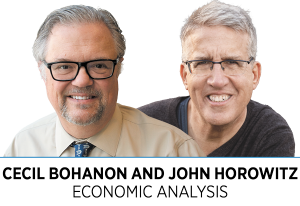Subscriber Benefit
As a subscriber you can listen to articles at work, in the car, or while you work out. Subscribe Now The consumer price index, calculated by the U.S. Bureau of Labor Statistics, and the personal consumption expenditures index, calculated by the U.S. Bureau of Economic Analysis, are the two most common measures of inflation. From December to January, the CPI indicated that the year-to-year inflation fell from 6.5% to 6.4%, while the PCE rose from 5.3% to 5.4%. Of course, this muddles the inflation picture but leads us to inquire into the differences between the two measures.
The consumer price index, calculated by the U.S. Bureau of Labor Statistics, and the personal consumption expenditures index, calculated by the U.S. Bureau of Economic Analysis, are the two most common measures of inflation. From December to January, the CPI indicated that the year-to-year inflation fell from 6.5% to 6.4%, while the PCE rose from 5.3% to 5.4%. Of course, this muddles the inflation picture but leads us to inquire into the differences between the two measures.
There are several differences, but here’s a big one:
Any inflation measure starts with a bundle of goods and services that presumably reflects some average of actual consumption. Inflation is when it becomes more expensive to purchase that bundle of goods. Suppose our typical household consumes 50 apples and 50 oranges a month, and the initial price of both apples and oranges is $1. A household can buy the bundle for $100. Let’s say that, the next month, apple prices rise to $2 while orange prices rise to $1.50. The cost of the market basket is now $175, so the basket’s price has risen 75%.
However, economists have long noted this ignores the reality that consumers mitigate price hikes by substituting relatively less expensive goods for the relatively more expensive ones. While both fruits rise in dollar price, the cost of oranges compared with that of apples decreases. The 75% price increase does not calculate for the possibility of substituting oranges for apples. Suppose that, in the second month, consumers adjust, consuming 35 apples and 65 oranges. That basket’s price increased from $100 to $167.50—reflecting a 67.5% price increase.
So which calculation method is “right”? Most economists think neither is definitive. If the first month’s basket overestimates price rises, the second month’s basket underestimates them. About 100 years ago, Yale economist Irving Fisher argued an “ideal” measure would use a geometric average of the change in the price of the two bundles, which is the convention most economists accept. (In this measure, the fruit bundle’s price rose 71.2%.)
The PCE more closely approximates the Fisher ideal since the bundle of goods and services is updated quarterly, while the CPI bundle of goods and services is updated every two years. This is one reason the Fed “prefers” the PCE to the CPI. We will see if the recent divergence repeats in the next data release.•
__________
Bohanon and Horowitz are professors of economics at Ball State University. Send comments to [email protected].
Please enable JavaScript to view this content.
